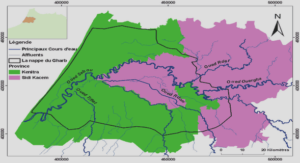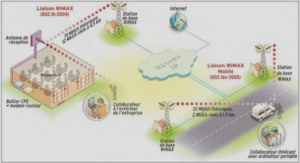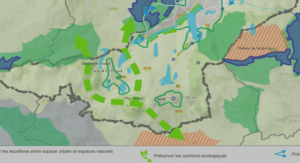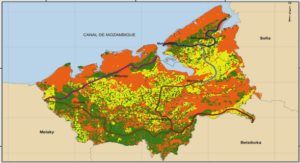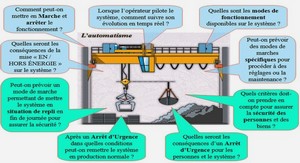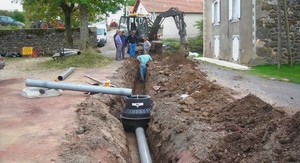Télécharger le fichier original (Mémoire de fin d’études)
Context
Polypropylene-based materials are widespread in the automotive industry due to their low cost, chemical resistance, good mechanical properties or even recyclability. Thermo-Plastic Olefins (TPO), which refer to blend of polypropylene with ethylene-propylene rubber (EPR) in order to confer scratch and impact resistance, are particularly used in exterior parts such as bumpers and side protectors. Nowadays, these TPO are commonly synthesized by multistage polymerization, which improves compatibility of phases and thereby enhances their mechanical properties as well as their processability (high Melt Flow Rate). They still account for more than 50% in volume and 25% in value of the polymer amount in a car and their use, including in thermoplastic composites, is intended to be increasingly popular in the perspective of lightening vehicles. Indeed, this is an important leverage in order to satisfy the requirements of the European regulation (N° 443/2009) in terms of CO2 emissions for light-duty vehicles (95 g CO2/km before 2020).
The main drawback of polypropylene is its degradation under the combined effects of oxygen with temperature (thermal oxidation) or UV-light (photooxidation). Indeed, most of the alteration of both mechanical and aspect properties (loss of gloss, whitening, chalking…) has been ascribed to the occurrence of macromolecular chain scissions and the subsequent formation of a lattice of micro-cracks [1-3]. Today, it is widely accepted, in the scientific community of polymer degradation, that the relevant scale to investigate these phenomena is the chemistry of oxidation. The subsequent alteration of upper-scale properties can theoretically be calculated provided that the structure-properties relationships have been identified. The issue is thus to ensure the durability of materials specifications, particularly in terms of perceived quality, and thereby focusing on aspect properties.
In a demanding context of time-to-market reduction, the challenge for R&D departments is to shorten validation periods while aging tests in real conditions are very time-consuming. Different strategies can be envisaged:
(i) The choice of materials (and their suppliers) can be restricted to a shortened list which has passed validations test upstream, at the expense of the innovation responsiveness.
(ii) The aging tests can be accelerated by applying harsher conditions in terms of UV-light intensity, temperature or frequency of rainfalls for instance. However, these accelerated test methods must be representative of the real-use conditions in order to be reliable: in other words, the relative importance of the different phenomena under competition must be kept unchanged. This point has been particularly emphasized in the so-called mechanistic approach, supported by Lemaire, Gardette and coworkers (Clermont-Ferrand), which consists in ensuring that the mechanisms of degradation are similar in natural (outdoor) and accelerated exposure conditions [4, 5].
(iii) The impact of the various factors (environmental stresses and materials constituents) on polymer aging can be capitalized (feedback). This can be done by “statistical modeling”: lifetimes relative to a given property are interpolated generally using polynomials. The other possibility is to simulate the chemical changes depending upon the aging factors, namely the composition of the material and the harshness of the environmental factors. This can be done by applying an approach of kinetic modeling. The main advantage of this latter approach is its heuristic feature thereby enabling extrapolation of the model to longer durations or softer aging conditions.
To date, there is still a long way to go before obtaining a tool viable for lifetime prediction of commercial materials in real-use conditions. Many physicochemical phenomena are involved as a consequence of the complex industrial formulations containing stabilizers [6] –additives conferring the long term stability- fillers or pigments [3, 7, 8]. Modeling their effects on aging requires understanding the impact of each environmental factor and material constituent, their possible interactions depending on the initial state (amount of structural defaults [6, 9] and thermal history given by the processing conditions [10]). The scope of this thesis has thus been restricted to the case of the unstabilized TPO, free of any additive or filler.
This study is the result of the collaboration between the laboratory of Processing and Engineering in Mechanics and Materials (PIMM, Arts et Metiers ParisTech, CNRS) and the automotive company Renault in the framework of the project POLAR (POLymer Aspect Reliability)
Objectives
The aim of this thesis thus consists in designing a kinetic model for the photothermal oxidation of isotactic polypropylene and its impact copolymers. This approach has been initiated for two decades in the PIMM laboratory by investigating alternately the effect of temperature [11], UV-light [12] or oxygen partial pressure [13] on the oxidation kinetics of polypropylene and its subsequent properties changes [14]. An important stake will be to upgrade the numerical tool established for thermal oxidation to the case of the photothermal oxidation. Besides a tool for lifetime prediction, numerical simulation must be above all considered as a research tool, a way to put to the test various mechanistic assumptions and thus to elucidate the impact of the exposure conditions on the oxidation kinetics. A particular attention will be also dedicated to the aging methodology and their reliability.
Structure of the dissertation
The literature overview, given in chapter aims at making an inventory of the involved mechanisms in photothermal oxidation, focusing particularly on additional mechanisms induced by the UV-light mainly initiation processes. A particular attention will be dedicated to the mechanistic considerations which lay the foundations of the kinetic modeling approach. Chapter 2, will focus on methodological aspects in relation with the sources of errors, both experimental and numerical, which is necessary in order to apprehend the reliability of the proposed model.
The first results chapter will be dedicated to thermal oxidation which constitutes the core and a subset of the photothermal model since temperature is an intensive quantity in any system. However, the thermal model has been established in very different conditions from solid [8, 11, 14, 15] to molten states [16], thereby resulting in slight predictive discrepencies depending upon the mechanistic and kinetic assumptions. Thus, the challenge will consist in unifying the different proposals of thermal model and checks its validity whatever the temperature, oxygen pressure or material thickness. In chapter 3, the emissions of volatile organic compounds (VOCs) during the thermal oxidation of polypropylene at 140°C will be monitored in real-time by using Fourier transform ion cyclotron resonance mass spectrometry. This original method enables to investigate the impact of VOCs emissions on the mechanisms of polypropylene thermal oxidation and its kinetic modeling. Following these complementary mechanistic considerations, chapter 4 and 5 will be dedicated to establishing a unique kinetic model for thermal oxidation, mainly focusing on the impact of oxygen transport properties. In chapter 4, the oxygen solubility will be shown to be a critical parameter to report the whole diversity of iPP oxidation behaviors, in close connection with the effect of oxygen partial
Table des matières
Liste des symboles et acronymes
Introduction
1 Etat de l’art
1.1 Introduction
1.2 Normes et recommandations
1.2.1 Fondements des normes
1.2.1.1 Seuil de 4 W/kg et élévation de température de 1°C
1.2.1.2 Facteurs de précaution et différents environnements
1.2.1.3 Moyenne temporelle de 6 min
1.2.2 Niveaux de référence et restrictions de base
1.2.2.1 Définition des niveaux de référence
1.2.2.2 Définition des restrictions de base
1.2.2.3 Cas de multiples expositions
1.2.2.4 Lien entre niveaux de référence et restrictions de base
1.2.3 Evolution des normes
1.2.3.1 Normes publiées par l’ANSI et l’IEEE
1.2.3.2 Normes publiées par l’IRPA et l’ICNIRP
1.2.4 Autres normes spécifiques aux environnements militaires
1.2.4.1 Norme de l’OTAN : STANAG 2003
1.2.4.2 Norme IEEE pour les milieux militaires
1.2.4.3 Norme militaire spécifique à la France : Directive du Ministère de la
Défense
1.3 Effets avérés d’une exposition
1.3.1 Introduction
1.3.2 Mécanismes d’interaction lors d’une exposition électromagnétique
1.3.3 Principales études sur les effets des rayonnements RF
1.3.3.1 Effets thermiques reconnus lors d’exposition RF : sensations et thermorégulation
1.3.3.2 Effets sur la reproduction et le développement
1.3.3.3 Maladies de l’oeil
1.3.3.4 Effets biochimiques
1.3.3.5 Perception auditive des RF et électro-hypersensibilité
1.3.3.6 Etudes sur le cancer
1.3.4 Conclusion : effets établis formant la base normative
1.4 Moyens de mesure dosimétrique
1.4.1 Mesures expérimentales de DAS
1.4.2 Moyens numériques
1.4.2.1 Modèles numériques de l’humain
1.4.2.2 Outils de simulation
1.5 Positionnement et objectifs de la thèse
2 Caractérisation électromagnétique d’une exposition en bandes HF et VHF
2.1 Introduction
2.2 Comparaison de trois fantômes sur les valeurs de DAS
2.2.1 En onde plane, polarisation verticale : Configuration 1
2.2.2 En onde plane, autres polarisations et angles d’incidence
2.2.3 En champ proche avec un portatif
2.3 Influence des tissus en surface des fantômes
2.3.1 Influence de la graisse et de la peau
2.3.2 Influence d’une couche d’eau
2.3.3 Influence d’une couche de tissu/vêtement
2.4 Conclusion
3 Caractérisation thermique d’une exposition en bandes HF et VHF
3.1 Introduction
3.2 Modélisation de la température dans le corps et de la thermorégulation lors d’une exposition
RF
3.3 Etude de l’influence de paramètres extérieurs : température ambiante et durée d’exposition
3.3.1 Influence de la température ambiante
3.3.2 Influence de la durée d’exposition
3.4 Evolution de la température locale lors d’une exposition
3.5 Caractérisation de la température du corps entier par rapport au DAS corps entier
3.6 Fantôme homogène et simulation thermique
3.7 Conclusion
4 Lien entre différentes grandeurs dosimétriques
4.1 Introduction
4.2 Etat de l’art sur la modélisation du corps humain par des antennes et des circuits
électriques
4.2.1 Antenne équivalente à l’être humain
4.2.2 Circuit équivalent à l’être humain
4.3 Influence de l’impédance d’onde sur les courants induits et le DAS
4.3.1 Présentation de l’étude
4.3.2 Modélisation du corps par des circuits électriques pour l’évaluation du courant
induit selon la posture du corps
4.3.2.1 Fantôme isolé équivalent à une antenne électrique
4.3.2.2 Fantôme en boucle équivalent à une antenne magnétique
4.3.3 Résultats
4.3.3.1 Exposition théorique en champ haute impédance
4.3.3.2 Exposition théorique en champ basse impédance
4.3.3.3 Exposition réaliste : champ rayonné par une antenne placée sur le toit
d’un véhicule
4.3.4 Conclusion
4.4 Influence du champ électrique externe sur les courants induits : Modélisation du corps
par un circuit de Thévenin
4.4.1 Modélisation de l’impédance du corps par un circuit de Thévenin
4.4.1.1 Modèle électrique de la tension Vth
4.4.1.2 Modèle électrique de l’impédance Zth
4.4.1.3 Validation du circuit de Thévenin
4.4.2 Etude des limites actuelles : lien entre les courants induits et les champs électriques
externes
4.4.3 Conclusion
4.5 Evaluation du DAS corps entier et 10 g dans un fantôme homogène à partir des courants
induits
4.5.1 Présentation
4.5.2 Relation entre les courants induits et le DAS
4.5.3 Résultats et validation des formules
4.5.3.1 Fantôme simplifié équivalent au fantôme homogène Duke
4.5.3.2 Exposition à une onde plane
4.5.3.3 Exposition à un champ haute impédance
4.5.3.4 En champ basse impédance
4.5.3.5 Champ rayonné par une antenne sur véhicule
4.6 Conclusion
5 Proposition d’une nouvelle méthode d’évaluation dosimétrique
5.1 Introduction
5.2 Evaluation des DAS à partir du champ électrique
5.2.1 Application sur un fantôme simplifié homogène
5.2.2 Application sur le fantôme Duke homogène
5.2.3 Conclusion
5.3 Développement de tissus homogènes ou hétérogènes simples
5.3.1 Tissu homogène
5.3.2 Combinaison à 2 tissus
5.3.3 Combinaison à 3 tissus
5.3.3.1 Exposition à une onde plane
5.3.3.2 Exposition à un champ haute impédance
5.3.3.3 Exposition à un champ rayonné par une antenne placée sur un véhicule
5.3.3.4 Evolution de l’hétérogène simple à 3 tissus
5.4 Conclusion
Conclusions et Perspectives
Bibliographie
A Principales limites des normes civiles IEEE et ICNIRP entre 1974 et 2005
B Tissus constituant les fantômes Duke, Ella et Hugo
B.1 Tissus hétérogènes
B.2 Tissu homogène
C Fantôme simplifié équivalent à la morphologie du fantôme Ella
C.1 Fantôme simplifié
C.2 Résultats en onde plane
D Compléments au chapitre 4 : validation des formules de calcul du DAS pour un
fantôme placé à l’intérieur d’un véhicule
D.1 Introduction
D.2 Résultats
D.2.1 Exposition en VHF
D.2.2 Exposition en HF
D.2.3 Conclusion
E Compléments au chapitre 3 : Exposition électromagnétique au-delà des limites normatives
et élévations de température associées
E.1 Présentation de l’étude
E.2 Résultats
E.3 Conclusion
F Liste des publications

